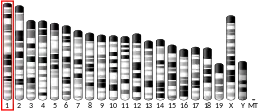| CMKLR2 | |||||||||||||||||||||||||||||||||||||||||||||||||||
|---|---|---|---|---|---|---|---|---|---|---|---|---|---|---|---|---|---|---|---|---|---|---|---|---|---|---|---|---|---|---|---|---|---|---|---|---|---|---|---|---|---|---|---|---|---|---|---|---|---|---|---|
| Identifiers | |||||||||||||||||||||||||||||||||||||||||||||||||||
| Aliases | CMKLR2, G protein-coupled receptor 1, chemerin chemokine-like receptor 2, GPR1 | ||||||||||||||||||||||||||||||||||||||||||||||||||
| External IDs | OMIM: 600239 MGI: 2385324 HomoloGene: 21094 GeneCards: CMKLR2 | ||||||||||||||||||||||||||||||||||||||||||||||||||
| |||||||||||||||||||||||||||||||||||||||||||||||||||
| |||||||||||||||||||||||||||||||||||||||||||||||||||
| |||||||||||||||||||||||||||||||||||||||||||||||||||
| |||||||||||||||||||||||||||||||||||||||||||||||||||
| |||||||||||||||||||||||||||||||||||||||||||||||||||
| Wikidata | |||||||||||||||||||||||||||||||||||||||||||||||||||
| |||||||||||||||||||||||||||||||||||||||||||||||||||
G protein-coupled receptor 1, also known as GPR1, is a protein that in humans is encoded by the GPR1 gene.[5][6]
GPR1 is a member of the G protein-coupled receptor family of transmembrane receptors. It functions as a receptor for chemerin.[7] Other receptors for chemerin include CMKLR1 and CCRL2.
References
- 1 2 3 ENSG00000283448 GRCh38: Ensembl release 89: ENSG00000183671, ENSG00000283448 - Ensembl, May 2017
- 1 2 3 GRCm38: Ensembl release 89: ENSMUSG00000046856 - Ensembl, May 2017
- ↑ "Human PubMed Reference:". National Center for Biotechnology Information, U.S. National Library of Medicine.
- ↑ "Mouse PubMed Reference:". National Center for Biotechnology Information, U.S. National Library of Medicine.
- ↑ "Entrez Gene: GPR1 G protein-coupled receptor 1".
- ↑ Marchese A, Docherty JM, Nguyen T, Heiber M, Cheng R, Heng HH, Tsui LC, Shi X, George SR, O'Dowd BF (October 1994). "Cloning of human genes encoding novel G protein-coupled receptors". Genomics. 23 (3): 609–18. doi:10.1006/geno.1994.1549. PMID 7851889.
- ↑ Barnea G, Strapps W, Herrada G, Berman Y, Ong J, Kloss B, Axel R, Lee KJ (January 2008). "The genetic design of signaling cascades to record receptor activation". Proc. Natl. Acad. Sci. U.S.A. 105 (1): 64–9. doi:10.1073/pnas.0710487105. PMC 2224232. PMID 18165312.
Further reading
- Shimizu N, Soda Y, Kanbe K, et al. (1999). "An Orphan G Protein-Coupled Receptor, GPR1, Acts as a Coreceptor To Allow Replication of Human Immunodeficiency Virus Types 1 and 2 in Brain-Derived Cells". J. Virol. 73 (6): 5231–9. doi:10.1128/JVI.73.6.5231-5239.1999. PMC 112576. PMID 10233994.
- Tokizawa S, Shimizu N, Hui-Yu L, et al. (2000). "Infection of mesangial cells with HIV and SIV: identification of GPR1 as a coreceptor". Kidney Int. 58 (2): 607–17. doi:10.1046/j.1523-1755.2000.00207.x. PMID 10916084.
- Strausberg RL, Feingold EA, Grouse LH, et al. (2003). "Generation and initial analysis of more than 15,000 full-length human and mouse cDNA sequences". Proc. Natl. Acad. Sci. U.S.A. 99 (26): 16899–903. Bibcode:2002PNAS...9916899M. doi:10.1073/pnas.242603899. PMC 139241. PMID 12477932.
- Kang MK, Kameta A, Shin KH, et al. (2003). "Senescence-associated genes in normal human oral keratinocytes". Exp. Cell Res. 287 (2): 272–81. doi:10.1016/S0014-4827(03)00061-2. PMID 12837283.
- Gerhard DS, Wagner L, Feingold EA, et al. (2004). "The Status, Quality, and Expansion of the NIH Full-Length cDNA Project: The Mammalian Gene Collection (MGC)". Genome Res. 14 (10B): 2121–7. doi:10.1101/gr.2596504. PMC 528928. PMID 15489334.
- Hillier LW, Graves TA, Fulton RS, et al. (2005). "Generation and annotation of the DNA sequences of human chromosomes 2 and 4". Nature. 434 (7034): 724–31. Bibcode:2005Natur.434..724H. doi:10.1038/nature03466. PMID 15815621.
- Jinno-Oue A, Shimizu N, Soda Y, et al. (2005). "The synthetic peptide derived from the NH2-terminal extracellular region of an orphan G protein-coupled receptor, GPR1, preferentially inhibits infection of X4 HIV-1". J. Biol. Chem. 280 (35): 30924–34. doi:10.1074/jbc.M500195200. PMID 15919664.
- Otsuki T, Ota T, Nishikawa T, et al. (2007). "Signal sequence and keyword trap in silico for selection of full-length human cDNAs encoding secretion or membrane proteins from oligo-capped cDNA libraries". DNA Res. 12 (2): 117–26. doi:10.1093/dnares/12.2.117. PMID 16303743.
- Kimura K, Wakamatsu A, Suzuki Y, et al. (2006). "Diversification of transcriptional modulation: Large-scale identification and characterization of putative alternative promoters of human genes". Genome Res. 16 (1): 55–65. doi:10.1101/gr.4039406. PMC 1356129. PMID 16344560.
This article is issued from Wikipedia. The text is licensed under Creative Commons - Attribution - Sharealike. Additional terms may apply for the media files.




